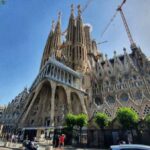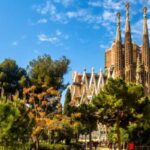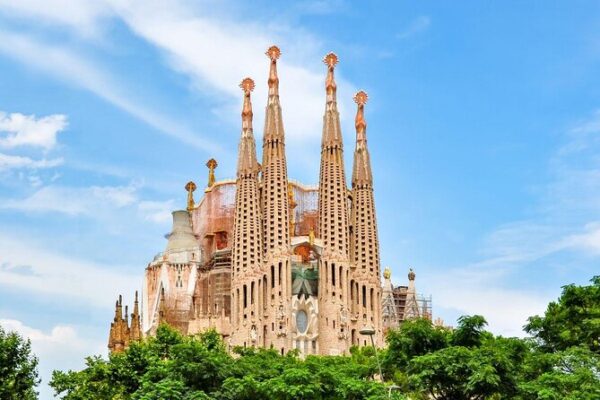
Barcelona, a city rich in culture and history, offers a vibrant tapestry of iconic landmarks and breathtaking natural beauty. Visitors are drawn to its architectural marvels, lush parks, and fascinating wildlife, creating a unique blend of experiences that captivate travelers from around the world.
In this journey, we will explore the city's most celebrated sites, revealing the stories behind them and the creatures that inhabit its green spaces. Join us as we embark on an adventure, **From Sagrada Familia to Barcelona Zoo: Exploring Barcelona's Iconic Landmarks and Wildlife**, where art, architecture, and nature intertwine harmoniously.
Exploring the Architectural Marvel of Sagrada Familia: A Barcelona Icon
The Sagrada Familia, designed by the renowned architect Antoni Gaudí, stands as a testament to the fusion of nature and architecture. This basilica, still under construction since 1882, showcases Gaudí's distinctive style, characterized by organic forms and intricate details. Its towering spires, representing the twelve apostles, create a breathtaking skyline that captivates both locals and tourists alike.
Visitors can explore the structural innovations that define the Sagrada Familia, including the use of hyperboloid structures and parabolic arches. These elements not only enhance the building's aesthetic appeal but also provide remarkable stability. The façade tells biblical stories through sculptures and carvings, inviting guests to engage with the rich narrative woven into its walls.
- Location: Carrer de Mallorca, 401, 08013 Barcelona
- Height: 172.5 meters when completed
- Estimated Completion: 2026, marking Gaudí’s centenary
As you wander through its interior, the play of light through stained glass windows creates an ethereal atmosphere, reminiscent of a forest. This architectural marvel not only serves as a religious site but also as a symbol of Barcelona's artistic spirit, making it a must-visit destination for anyone exploring the city's iconic landmarks.
Unveiling the Enchantment of Park Güell: Nature Meets Art in Barcelona
Park Güell, a UNESCO World Heritage Site, is a vibrant showcase of Gaudí’s genius, where art and nature coexist in perfect harmony. Nestled on Carmel Hill, this enchanting park is a testament to Gaudí's vision of integrating architectural wonders with the surrounding landscape. Visitors can stroll through its whimsical pathways, adorned with colorful mosaics and organic shapes that mimic the forms of nature.
One of the park's standout features is the serpentine bench, which winds around the main terrace, offering breathtaking views of Barcelona. The bench is not only a functional piece of art but also a masterclass in the use of trencadís, a mosaic technique that employs broken tiles to create intricate designs. This unique craftsmanship invites visitors to marvel at the creativity that permeates every corner of Park Güell.
- Highlights of Park Güell:
- Colorful mosaics and sculptures
- Iconic salamander statue, known as "El Drac"
- Stunning panoramic views of the city
- Visitor Information:
- Location: Carrer d'Olot, 5, 08024 Barcelona
- Opening Hours: 9 AM to 9 PM (varies by season)
- Admission Fee: Ticket required for the monumental zone
As you explore the park, you'll find that it not only serves as a recreational space but also as a canvas for artistic expression. The lush gardens, vibrant structures, and natural landscapes create a magical atmosphere that enchants visitors of all ages. Park Güell is more than just a park; it embodies the spirit of Barcelona’s artistic heritage, making it a vital stop on any exploration of the city’s iconic landmarks.
A Journey Through History: Discovering the Gothic Quarter of Barcelona
The Gothic Quarter, known as "Barri Gòtic," is the heart of Barcelona's historical charm, where narrow medieval streets lead you through centuries of history. This captivating neighborhood is home to some of the city's oldest architecture, offering a glimpse into its rich past. As you wander through its labyrinthine alleys, you'll discover:
- Barcelona Cathedral: A stunning example of Gothic architecture, with intricate details and a serene cloister.
- Roman Walls: Remnants of the ancient city, showcasing the Roman influence that shaped Barcelona.
- Plaça del Rei: A historic square that served as the royal palace and is steeped in tales of the past.
As you explore this vibrant area, the atmosphere is infused with stories of knights and royalty, making it an essential stop for history enthusiasts. Hidden squares and quaint cafés provide perfect spots to pause and absorb the surroundings, creating an immersive experience.
Don't miss the chance to visit the Picasso Museum, which is nestled within the Gothic Quarter. This museum houses an extensive collection of artworks from the famous artist’s formative years, drawing connections between his early influences and the enchanting neighborhood. Here, visitors can appreciate:
- Over 4,000 works by Picasso, showcasing his evolution as an artist.
- Unique architectural features of the museum, which are reminiscent of Gothic design.
- Interactive exhibitions that engage visitors with art history.
In addition to its historical and artistic offerings, the Gothic Quarter is alive with local culture. Street performers, artisan shops, and traditional tapas bars add to the vibrant tapestry of everyday life, making each visit a unique experience filled with discovery.
Wild Encounters: What to Expect at Barcelona Zoo
At Barcelona Zoo, visitors are treated to a captivating experience that goes beyond just observing animals. This vibrant wildlife sanctuary, located within the scenic Parc de la Ciutadella, is home to over 400 species, providing a unique opportunity to encounter diverse wildlife from around the globe. Expect to see everything from majestic lions to playful lemurs, each offering a glimpse into the wonders of nature.
The zoo prioritizes animal welfare and conservation, making it an educational hub for all ages. Guests can participate in various interactive programs, such as animal feeding sessions and behind-the-scenes tours. These experiences not only entertain but also raise awareness about the importance of wildlife preservation and the challenges many species face in the wild.
- Key Attractions:
- The African Savannah exhibit, featuring giraffes and zebras.
- Penguin Island, where you can watch these charming birds in action.
- The Reptile House, showcasing a variety of snakes and lizards.
- Visitor Information:
- Location: Parc de la Ciutadella, 08003 Barcelona
- Opening Hours: 10 AM to 5 PM (hours vary seasonally)
- Admission Fee: Ticket prices vary depending on age and access.
As you wander through the zoo, look out for the educational displays that provide insights into the habitats and behaviors of the animals. Special events and workshops often highlight conservation efforts and the zoo's role in protecting endangered species. Whether you're a wildlife enthusiast or visiting with family, Barcelona Zoo promises an enriching experience that connects visitors with the beauty of the animal kingdom.
Connecting with Nature: The Role of Barcelona's Parks and Gardens
Barcelona's parks and gardens serve as essential green lungs in the bustling urban landscape, offering residents and visitors alike a chance to connect with nature amidst the vibrancy of city life. As the city evolves, these green spaces become sanctuaries that promote relaxation and mindfulness, allowing individuals to escape from the hustle and bustle. Noteworthy parks like Parc de la Ciutadella and Montjuïc not only provide recreational areas but also foster biodiversity, supporting various species of flora and fauna.
Among the many benefits of these parks, the promotion of physical activity and mental well-being stands out. Here, visitors can engage in a variety of activities, such as:
- Walking and jogging: Scenic trails provide a perfect setting for exercise.
- Picnicking: Spacious lawns invite families and friends to gather and enjoy meals outdoors.
- Gardening: Community gardens encourage residents to cultivate their green thumbs.
Moreover, these urban oases play a crucial role in environmental sustainability. By helping to reduce air pollution and manage urban heat, parks contribute to a healthier ecosystem. Barcelona's parks are designed with native plant species, which require less water and maintenance, making them sustainable choices for the city. Initiatives such as tree planting campaigns enhance the overall green canopy, which is vital for improving air quality and providing habitats for wildlife.
In summary, the role of Barcelona's parks and gardens extends beyond mere aesthetics; they are vital components of urban life that enrich the community's connection to nature. By providing spaces for recreation, promoting biodiversity, and enhancing environmental health, these green areas contribute significantly to the city’s charm and livability. Whether one seeks solace in nature or engaging social interactions, the parks of Barcelona offer something for everyone.
Cultural Highlights: Must-Visit Landmarks Beyond Sagrada Familia and Zoo
Barcelona is a city that thrives on its historical and artistic heritage, and beyond the Sagrada Familia and the Zoo, there are numerous must-visit landmarks that reflect this rich culture. One such gem is the Pavilion Mies van der Rohe, a masterpiece of modern architecture that showcases simplicity and elegance. Visitors can admire its sleek lines and tranquil water features, offering a striking contrast to the ornate styles found elsewhere in the city.
Another notable site is the Palau de la Música Catalana, an architectural wonder that combines intricate mosaics, stained glass, and an extraordinary concert hall. This UNESCO World Heritage Site is renowned for its acoustics and hosts a variety of performances. The opulent design makes every concert a feast for the senses, making it an essential stop for culture lovers.
- Key Features of Palau de la Música Catalana:
- Stunning stained glass skylight
- Colorful mosaics depicting Catalan culture
- Guided tours available for deeper insights
- Location: Carrer del Palau de la Música, 4-6, 08003 Barcelona
Moreover, the Hospital de Sant Pau, another UNESCO-listed site, exemplifies Catalan Modernism through its vibrant tiles and elaborate sculptures. Designed by Lluís Domènech i Montaner, this hospital complex not only serves healthcare needs but also stands as a testament to innovation and artistry in architecture. Its landscaped gardens and stunning pavilions provide a peaceful retreat in the heart of the city.
- Highlights of Hospital de Sant Pau:
- Beautifully restored Art Nouveau buildings
- Rich historical significance
- Guided tours and exhibitions available
- Location: Carrer de Sant Antoni Maria Claret, 167, 08025 Barcelona
 The Fascinating History of Barcelona's Sagrada Familia: A Brief Overview
The Fascinating History of Barcelona's Sagrada Familia: A Brief Overview The Ultimate Guide to Staying near Sagrada Familia in Barcelona
The Ultimate Guide to Staying near Sagrada Familia in BarcelonaIf you want to know other articles similar to From Sagrada Familia to Barcelona Zoo: Exploring Barcelona's Iconic Landmarks and Wildlife you can visit the category WHERE YOU CAN GO.
Leave a Reply










Read more!